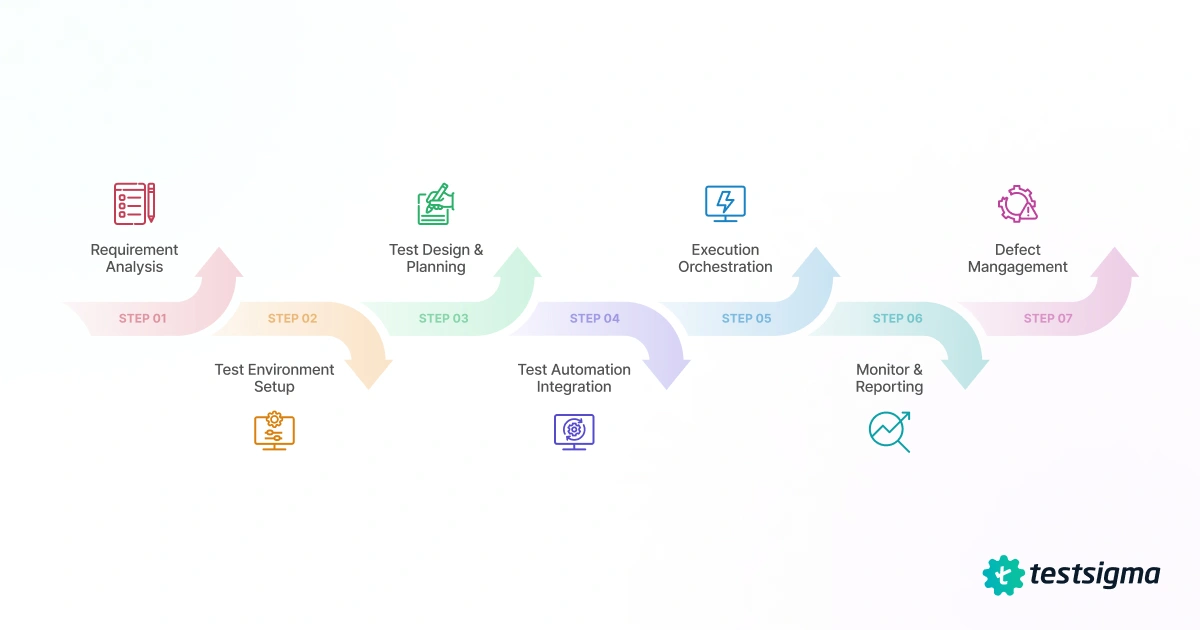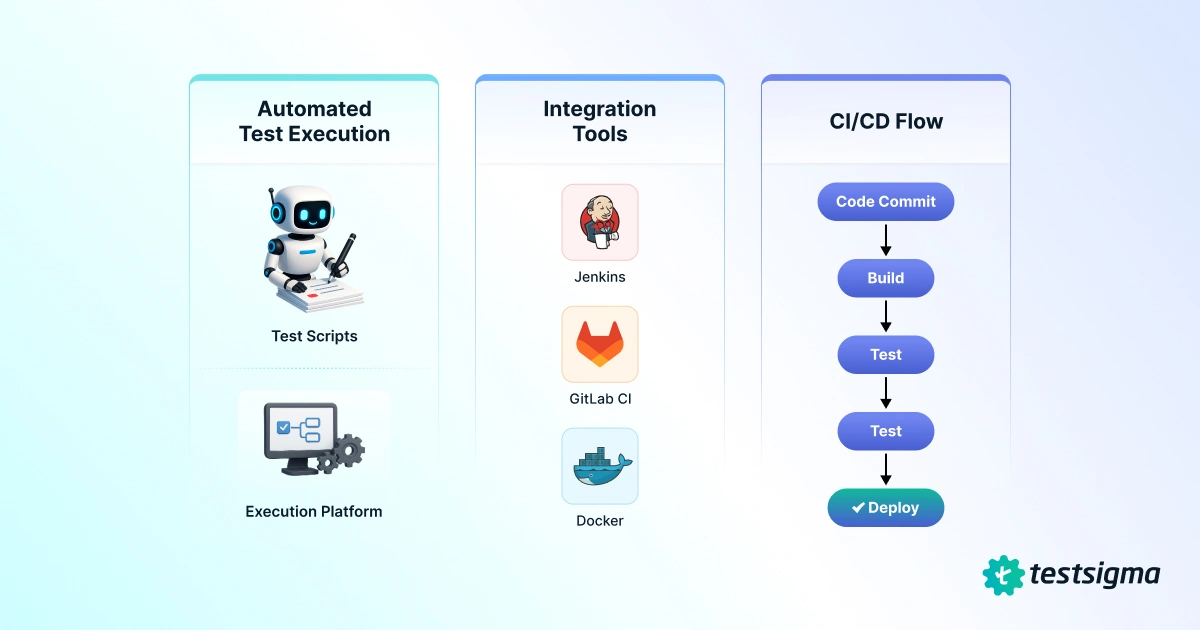Modern software delivery demands speed, consistency, and collaboration, and that’s where test orchestration comes in. It’s the practice of coordinating and automating multiple testing processes, tools, and environments to ensure everything runs seamlessly from start to finish. Instead of managing scattered tests manually, teams can use orchestration to unify their pipelines, boost efficiency, and gain real-time visibility into test outcomes.
In this guide, we’ll explain test orchestration, why it matters, and how you can start orchestrating your tests like a pro, using helpful tools like Testsigma along the way.
Table Of Contents
- 1 What Is Test Orchestration?
- 2 Why Test Orchestration Matters In Modern QA?
- 3 Benefits Of Test Orchestration
- 4 Test Orchestration Vs. Test Automation
- 5 How Test Orchestration Works: A Step-By-Step Process
- 6 Common Challenges In Test Orchestration
- 7 Best Practices For Effective Test Orchestration
- 8 Real-World Use Cases Of Test Orchestration
- 9 Future Of Test Orchestration In QA
- 10 Implementing Test Orchestration With Testsigma
- 11 Frequently Asked Questions
What is Test Orchestration?
At its core, test orchestration involves the automated coordination of your testing pipeline. It ensures that each test runs in the right order, at the right time, with the appropriate data, integrating various testing tools and environments into a cohesive workflow with minimal manual intervention.
Unlike standalone test automation, which focuses on executing individual tests, test orchestration manages the entire testing lifecycle.

When you think about CI/CD, it covers everything from integrating code changes to reliably deploying them to production. Test orchestration fits neatly within this pipeline by handling the testing portion with precision.
Why Test Orchestration Matters in Modern QA?
The evolution of DevOps and Agile methodologies calls attention to the need for rapid feedback loops and continuous integration.
Test orchestration addresses these needs by:
- Enhancing scalability and reliability: Orchestrated tests can be executed across multiple environments, ensuring consistent results and facilitating parallel testing.
- Accelerating release cycles: Automated and well-coordinated testing reduces bottlenecks, enabling faster delivery of features and fixes.
- Improving collaboration: By providing a unified testing framework, teams across development, QA, and operations can collaborate more effectively, aligning their efforts towards common goals.
According to the latest Capgemini World Quality Report, effective test orchestration is key to accelerating release cycles and improving collaboration in agile teams. This enables organizations to deliver higher-quality software faster in increasingly complex environments.
Benefits of Test Orchestration
As software grows more complex, simply running automated tests isn’t enough. Teams face challenges managing dependencies, environments, and timing. Test orchestration solves this by intelligently organizing and automating the entire testing process end-to-end.
Faster Release Cycles
Orchestrated testing ensures that automated tests are executed in a predefined sequence. This allows for quicker issue identification and resolution, shortening the overall release cycle.
Reduced Manual Effort
Orchestration minimizes the need for manual intervention by automating the coordination of tests. Your QA specialists can then spend less time chasing test runs and more time improving test strategy and quality.
Better Collaboration across Teams
When a unified system manages tests, everyone, from developers to testers to operations, stays on the same page. This shared visibility reduces miscommunication and builds trust across teams.
Improved Test Coverage and Quality
Orchestration allows running a wider range of tests on various environments and configurations. The result? More bugs caught before release and higher confidence in the software’s stability and performance.
Cost Efficiency in QA
Streamlining the testing process means fewer redundant tests and less firefighting. The smoother workflow saves time and budget, maximizing the value of your QA investments.
Test Orchestration Vs. Test Automation
While both test automation and test orchestration aim to improve testing efficiency, they serve distinct roles:
- Test automation focuses on automating individual test cases to execute them without human intervention. Repeating test cases must be automated to save time and reduce human error.
- Test orchestration manages the execution of automated tests, determining their sequence, timing, and integration with other tools and processes. You need to manage the execution of multiple automated tests, ensuring they run in the correct sequence and integrate seamlessly with your development pipeline.
In essence, test automation handles “what” is tested, while test orchestration addresses “how” and “when” tests are executed.
Key Differences in Goals
While these terms are often used interchangeably, they play distinct roles in the software testing lifecycle.
| Aspect | Test automation | Test orchestration |
| Primary goal | Automate individual test cases and execute scripts | Coordinate and manage the entire testing workflow and pipeline |
| Process management | Executes tests independently without a broader context | Manages dependencies, execution order, and timing among tests |
| Integration | Limited to specific tools or test frameworks | Integrates multiple testing tools, environments, and CI/CD pipelines |
| Human intervention | May require manual triggering and monitoring | Automates orchestration with minimal manual intervention |
Why automation matters for QA? – Know how Testsigma can transform your testing journey!
How Test Orchestration Works: A Step-by-step Process
Implementing test orchestration means combining your testing activities into a precise, automated flow that fits nicely with your development cycle.
Here’s a breakdown of the essential steps involved:
Test Planning and Tool Integration
Start by defining clear testing goals and choosing tools that work well with your existing development and deployment systems. The right tools and plans set the foundation for smooth orchestration.

Test Environment Setup
Prepare your testing environments so they closely resemble production. Proper setup helps avoid surprises caused by differences between test and live conditions.
Test Execution across Multiple Environments
Run your tests across various configurations and devices to catch issues early and ensure your software performs well everywhere it matters.
Reporting and Continuous Feedback
Collect the test data, review the results, and quickly feed insights back to your developers. This ongoing feedback loop helps teams fix problems quickly and maintain high quality.
Common Challenges in Test Orchestration
While test orchestration brings many benefits, teams often face hurdles when implementing and maintaining it.
Understanding these challenges is the first step toward overcoming them effectively.
- Toolchain complexity: Each tool has its configurations, updates, and quirks, making integration a tangled and time-consuming process.
- Integration overheads: Ensuring that the orchestration system fits with your existing CI/CD pipelines and communication platforms requires upfront effort and constant tuning.
- Data and environment dependencies: Tests rely on specific data sets and environment configurations. Managing these dependencies and ensuring consistency can be complex and error-prone.
- Maintenance issues: As tools evolve and project requirements change, keeping your orchestration framework updated and functioning properly demands ongoing attention and resources.
How to Solve These Challenges
- Standardize tools: Use standardized tools and frameworks to simplify integration and maintenance.
- Automate environment provisioning: Implement automation for setting up and tearing down test environments to reduce manual effort.
- Regularly update frameworks: Keep your orchestration frameworks and tools updated to leverage new features and improvements.
Best Practices for Effective Test Orchestration
These proven practices can simplify implementation, keep things running smoothly, and ensure your testing delivers maximum value.
- Shift-left testing: Start testing early in the development lifecycle to catch issues when they’re easier and cheaper to fix.
- Parallel execution strategies: Run tests side-by-side wherever possible. It speeds things up and gives you faster insights without sacrificing coverage.
- Integration with CI/CD pipelines: Ensure your orchestration tools play well with your existing CI/CD setup. Seamless integration keeps everything flowing without manual handoffs.
- Monitoring and reporting practices: Monitor tests closely. Good dashboards and clear reports help spot trends and nip problems in the bud.
- Security and compliance considerations: Don’t treat security as an afterthought. Build it into your orchestration framework to protect your software and data from day one.
Real-World Use Cases of Test Orchestration
Test orchestration is at the heart of modern QA, helping teams easily handle complex test suites across various applications and environments.
Here’s how it plays out in real-world scenarios:
Web App Testing
Orchestrating tests across different browsers and devices helps ensure consistent user experiences. Platforms like Testsigma can simplify running these tests concurrently and tracking results.
Mobile App Testing
With so many devices and OS versions, orchestration helps run tests methodically across mobile app testing diversity to maintain broad compatibility.
API Testing
Coordinated API testing across different environments with tools like Testsigma ensures your backend services communicate correctly and reliably.
Cross-Browser and Cross-Device Testing
Cross-browser testing and cross-device testing become manageable with orchestration, helping catch issues that affect real users.
Future of Test Orchestration in QA
Test orchestration is evolving rapidly alongside emerging technologies. It transforms how teams manage and run tests to keep up with fast-changing software landscapes.
- AI and ML in orchestrating tests: Artificial Intelligence and Machine Learning are helping orchestration tools predict where issues might crop up and make smarter decisions on which tests to run or skip.
- Predictive test orchestration: By analyzing historical test data and recent code changes, predictive orchestration can focus on tests most likely to fail.
- Rise of self-healing tests: Future tests won’t break just because a button moved or a UI element changed. Self-healing technologies allow tests to adapt automatically, cutting tedious maintenance and focusing teams on new challenges.
- Cloud-native orchestration: With cloud-native architectures, orchestration scales effortlessly, letting teams spin up tests across hundreds of devices and environments simultaneously without investing in costly infrastructure.
Implementing Test Orchestration with Testsigma
Testsigma is an agentic AI-powered test automation platform designed to streamline your entire test orchestration process. It’s built to help teams of all skill levels manage testing efficiently without getting bogged down by technical complexity.
- Test Data Management
Testsigma offers a straightforward interface for generating and managing test data. You can create multiple data variations, import from different formats, or write custom functions tailored to unique scenarios.
- Test Prioritization
With its cloud-based platform running 24/7, Testsigma allows you to prioritize and schedule tests according to your project needs. This means your critical tests run automatically, without manual intervention, even outside regular hours.
- Bug Management with AI
Testsigma uses AI to maintain up to 70% of your tests and automatically fix flaky ones. It captures detailed bug reports with screenshots, identifies high-risk areas, and sends alerts via email, Slack, or other platforms.
- Results Dashboard
The platform provides an intuitive dashboard displaying test results and execution trends across multiple environments. This helps you monitor performance easily and make data-backed decisions to refine your test strategy.
Along with this, Testsigma’s agent Atto has a specialized suite of agents for each action.
- Sprint Planner Agent – Plans your tests as soon as the JIRA sprint starts.
- Generator Agent – Automatically creates test cases from plain natural language with input from prompts, Figma designs, Jira requirements, videos, documents, images, and more.
- Optimizer Agent – Continuously analyzes and refines your test suite, eliminating redundancies and prioritizing high-impact test cases to maintain efficiency and stability.
- Runner Agent – Validates generated tests and allows execution directly within the browser, perfect for fast sanity checks and lightweight test runs.
- Analyzer Agent – Offers deep insights into test failures by correlating them with code changes, empowering teams to identify root causes faster and speed up release cycles.
- Bug Reporter Agent – Captures detailed failure data, including logs, screenshots, and step-by-step actions, making issue reporting seamless and accelerating debugging for developers.

In addition, Testsigma supports writing tests in plain English, running hundreds of tests in parallel, and testing across thousands of real devices and browser-OS combinations.
Its deep integrations with CI/CD pipelines and other development tools simplify embedding test orchestration in your continuous delivery flow.
Frequently Asked Questions
Yes, test orchestration helps reduce flaky tests by automating test execution, managing dependencies, and enabling retry strategies.
AI analyzes test results, predicts failures, prioritizes tests, and automatically fixes flaky or broken tests, making orchestration more innovative and efficient.
Test orchestration integrates deeply with CI/CD to automate end-to-end testing, providing fast feedback and ensuring consistent quality in every build and release.





